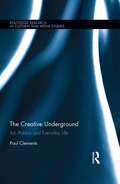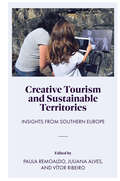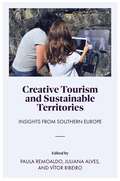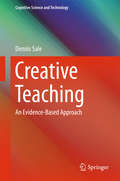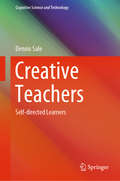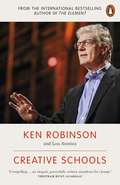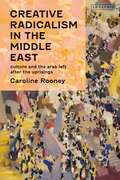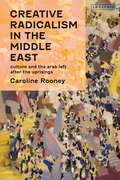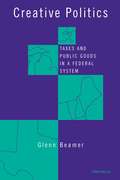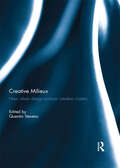- Table View
- List View
The Creative Underground: Art, Politics and Everyday Life (Routledge Research in Cultural and Media Studies)
by Paul ClementsPaul Clements champions the creative underground and expressions of difference through visionary avant-garde and resistant ideas. This is represented by an admixture of utopian literature, manifestos and lifestyles which challenge normality and attempt to reinvent society, as practiced for example, by radicals in bohemian enclaves or youth subcultures. He showcases a range of 'art' and participatory cultural practices that are examined sociopolitically and historically, employing key theoretical ideas which highlight their contribution to aesthetic thinking, political ideology, and public discourse. A reevaluation of the arts and progressive modernism can reinvigorate culture through active leisure and post-work possibilities beyond materialism and its constraints, thereby presenting alternatives to established understandings and everyday cultural processes. The book teases out the difficult relationship between the individual, culture and society especially in relation to autonomy and marginality, while arguing that the creative underground is crucial for a better world, as it offers enchantment, vitality and hope.
Creative Tourism and Sustainable Territories: Insights from Southern Europe
by Paula Remoaldo, Juliana AlvesCreative Tourism and Sustainable Territories: Insights from Southern Europe examines the growth and development of this emerging and fast developing area of tourism practice, while assessing it’s impacts on sustainability and regional development. Examples are drawn from across Southern Europe with analysis of Creative Tourism practices in Portugal, Italy, Spain, Greece, Croatia, Serbia, Montenegro, and Slovenia. Creative Tourism and Sustainable Territories features chapters from leading scholars that explore the definition and evolution of Creative Tourism, the roles played by urban and rural territories, the motivations and profiles of a creative tourist, best practices in Creative Tourism and contribution of festivals to Creative Tourism and territorial development providing an expansive study that will be of interest to researchers in Tourism Studies, Hospitality Studies, Sustainability, Economic Development and Cultural Industries, and Geography.
Creative Tourism and Sustainable Territories: Insights from Southern Europe
by Paula Remoaldo Juliana Alves Vítor RibeiroCreative Tourism and Sustainable Territories: Insights from Southern Europe examines the growth and development of this emerging and fast developing area of tourism practice, while assessing it’s impacts on sustainability and regional development. Examples are drawn from across Southern Europe with analysis of Creative Tourism practices in Portugal, Italy, Spain, Greece, Croatia, Serbia, Montenegro, and Slovenia. Creative Tourism and Sustainable Territories features chapters from leading scholars that explore the definition and evolution of Creative Tourism, the roles played by urban and rural territories, the motivations and profiles of a creative tourist, best practices in Creative Tourism and contribution of festivals to Creative Tourism and territorial development providing an expansive study that will be of interest to researchers in Tourism Studies, Hospitality Studies, Sustainability, Economic Development and Cultural Industries, and Geography.
Creative Teaching: An Evidence-Based Approach (Cognitive Science and Technology)
by Dennis SaleThis book contains an evidence-based pedagogic guide to enable any motivated teaching/training professional to be able to teach effectively and creatively. It firstly summarises the extensive research field on human psychological functioning relating to learning and how this can be fully utilised in the design and facilitation of quality learning experiences. It then demonstrates what creativity actually 'looks like' in terms of teaching practices, modelling the underpinning processes of creative learning design and how to apply these in lesson planning. The book, having established an evidence-based and pedagogically driven approach to creative learning design, extensively focuses on key challenges facing teaching professionals today. These include utilising information technologies in blended learning formats, differentiating instruction, and developing self-directed learners who can think well. The main purpose of the book is to demystify what it means to teach creatively, explicitly demonstrating the principles of good pedagogic design and communication strategies that underpin such activity. The message is clear - creative teaching competence is both a highly useful and a learnable capability.
Creative Teachers: Self-directed Learners (Cognitive Science and Technology)
by Dennis SaleThis book offers teaching/training professionals an evidence-based pedagogic guide to teaching effectively, efficiently and creatively – also known as Creative Teaching Competence. Firstly it summarizes the extensive research on human psychological functioning relating to learning and how this can be fully utilized in the design and facilitation of quality learning experiences that maximize attainment and engagement opportunities. Secondly, it demonstrates what creativity actually ‘looks like’ in terms of specific teaching practices, modeling the underpinning processes (syntax) of creative learning design. It then establishes Metacognitive Capability as the superordinate twenty-first century competency; in that this unique human attribute can significantly enhance the cognitive and motivational strategies essential for facilitating self-directed learning and wellbeing. The book helps teaching/training professionals to thoughtfully apply evidence-based knowledge and strategies to today’s challenges, such as developing self-directed learners, enhancing intrinsic motivation, utilizing technology for learning and teaching, developing curricula for twenty-first century competencies and optimally framing and developing the heightened teacher expertise required today.
Creative Spaces: Urban Culture and Marginality in Latin America
by Niall Geraghty Adriana Massidda'Creative Spaces: Urban Culture and Marginality' is an interdisciplinary exploration of the different ways in which marginal urban spaces have become privileged locations for creativity in Latin America. The essays within the collection reassess dominant theoretical notions of ‘marginality’ in the region and argue that, in contemporary society, it invariably allows for (if not leads to) the production of the new. While Latin American cities have, since their foundation, always included marginal spaces (due, for example, to the segregation of indigenous groups), the massive expansion of informal housing constructed on occupied land in the second half of the twentieth century have brought them into the collective imaginary like never before. Originally viewed as spaces of deprivation, violence, and dangerous alterity, the urban margins were later romanticized as spaces of opportunity and popular empowerment. Instead, this volume analyses the production of new art forms, political organizations and subjectivities emerging from the urban margins in Latin America, neither condemning nor idealizing the effects they produce. To account for the complex nature of contemporary urban marginality, the volume draws on research from a wide spectrum of disciplines, ranging from cultural and urban studies to architecture and sociology. Thus the collection analyzes how these different conceptions of marginal spaces work together and contribute to the imagined and material reality of the wider city.
Creative Social Policy: The Collective Emancipation of Human Potential
by Johannes KananenInnovative and forward-thinking in its approach, this book advocates for the liberation of people’s creative potential through the systematic transformation of work and capital. Providing a detailed account and analysis of current social policy, Johannes Kananen envisions an emancipatory societal development that prioritises fulfilling human need as opposed to the accumulation of private capital.Creative Social Policy argues that recent strands of academic social policy have contributed to economics imperialism and that practical social policy has become subordinate to the functions of capitalist production. In order to address this, Kananen makes crucial strategic proposals as a means of creating sustainable economic opportunities for all, including Universal Seed Money and Universal Basic Income. Given the instabilities caused by the COVID-19 pandemic, European war, austerity, the rise of right-wing populism and the climate crisis, Kananen highlights the urgent need to challenge the existing foundations of current policy making, and advocates for both emancipatory societal development and a cycle of co-creation of social policy knowledge to build a more sustainable future.This novel approach will make essential reading for students, scholars and academics specialising in social policy, political economy, political theory and sociology. Offering a unique outlook on social policy as we understand it, this book will also be of value to professionals and policy makers working in social, economic and ecological sustainability.
Creative Schools: Revolutionizing Education from the Ground Up
by Sir Ken Robinson Lou AronicaFrom the international bestselling author of The ElementKen Robinson is one of the world's most influential voices in education. In this inspiring, empowering book, he sets out a new vision for how education can be transformed to enable all young people to flourish. Filled with practical examples and groundbreaking research, it will inspire the change our children urgently need.'Compelling ... an elegant, powerfully written manifesto for change' Tristram Hunt, Guardian 'Inspires and brings a new sense of possibility to the goal of transforming education . . . This is a global game-changer' Brené Brown, author of Daring Greatly'Wonderful and enjoyable' Malala Yousafzai, Nobel Prize Laureate
Creative Revolution: A Study of Communist Ergatocracy (Routledge Library Editions: Revolution #7)
by Eden & PaulThis book, first published in 1920, is an analysis of socialist trends and a synthesis of proletarian aims. It attempts to establish the new political philosophy of left-wing socialists and coins a new term, ‘ergatocracy’ to mean ‘workers’ rule’ and the abolishment of class in the organisation of society.
Creative Revolution: A Study of Communist Ergatocracy (Routledge Library Editions: Revolution #7)
by Eden & PaulThis book, first published in 1920, is an analysis of socialist trends and a synthesis of proletarian aims. It attempts to establish the new political philosophy of left-wing socialists and coins a new term, ‘ergatocracy’ to mean ‘workers’ rule’ and the abolishment of class in the organisation of society.
Creative research communication: Theory and practice
by Emma Weitkamp Clare WilkinsonAimed at scholars interested in engaging the public with their research and postgraduate students exploring the practical aspects of research communication, this book provides a theoretically grounded introduction to new and emerging approaches to public engagement and research communication. Split into three sections, the reader first explores the historical approaches and current drivers for public engagement with research. Part two explores practical approaches to research engagement, from face-to-face communication in novel settings, such as festivals, through to artistic approaches, before considering new and emerging digital tools and approaches. Each practical chapter is theoretically grounded, exploring issues such as audience, interactivity, and impact. The final section explores ethical considerations in relation to public engagement as well as discussing the way that research communication fits into wider discussions about the impact of research, before concluding with a discussion around disseminating the success (or otherwise) of novel approaches to public engagement to wider groups, including public engagement practitioners.
Creative research communication: Theory and practice (PDF)
by Clare Wilkinson Emma WeitkampAimed at scholars interested in engaging the public with their research and postgraduate students exploring the practical aspects of research communication, this book provides a theoretically grounded introduction to new and emerging approaches to public engagement and research communication. Split into three sections, the reader first explores the historical approaches and current drivers for public engagement with research. Part two explores practical approaches to research engagement, from face-to-face communication in novel settings, such as festivals, through to artistic approaches, before considering new and emerging digital tools and approaches. Each practical chapter is theoretically grounded, exploring issues such as audience, interactivity, and impact. The final section explores ethical considerations in relation to public engagement as well as discussing the way that research communication fits into wider discussions about the impact of research, before concluding with a discussion around disseminating the success (or otherwise) of novel approaches to public engagement to wider groups, including public engagement practitioners.
Creative Reconstructions: Multilateralism and European Varieties of Capitalism after 1950 (Cornell Studies in Political Economy)
by Orfeo FioretosTwentieth-century Europe was an intense laboratory of capitalist experimentation. Confronted with economic booms and crises, technological revolutions, and economic globalization, Western Europe’s governments constantly explored alternative ways of managing domestic economic systems and international commerce. Bridging comparative and international political economy, Creative Reconstructions compellingly expands our understanding of the historic relationship between varieties of capitalism and international cooperation. Orfeo Fioretos’ pathbreaking analysis places multilateral institutions at the center of the study of capitalism. He highlights the role played by governments’ multilateral strategies in shaping the national trajectories of capitalism in Great Britain, France, and Germany. Fioretos shows that membership in international organizations such as the European Union and its precursors was an integral innovation in the domestic management of capitalism that came to play a central, if varied, role in shaping the evolution of modern market economies.Spanning six decades from the postwar period to the global crisis of 2008, Creative Reconstructions details the opportunities and constraints that multilateral engagements entailed for reforms in national financial, corporate governance, industrial relations, and innovation systems. In vivid analytical narratives, Fioretos shows how multilateral institutions served to reinforce and at times to undermine ambitious domestic reform programs. Creative Reconstructions deepens our understanding of modern capitalism in Europe and offers valuable lessons for regions beyond its borders.
Creative Rebellion for the Twenty-First Century: The Importance of Public and Interactive Art to Political Life in America
by D. BorosEmploying political philosophy to argue the need for social and public art projects to be a part of the everyday lives of Americans, Boros creates a new synthesis of philosophical ideas to support the political value of public art.
Creative Radicalism in the Middle East: Culture and the Arab Left after the Uprisings (Written Culture and Identity)
by Sorcha ThomsonAddressing the question of how neoliberal ideology has served to conflate the radical left with extremism, this book examines how the Arab left has asserted itself in the context of authoritarianism and Islamic extremism during and after the Arab uprisings. It examines how the Arab cultural left has offered a critique of the signifying practices of political hegemonies in the region and argues that though creative expression as constituted in the very language of the Arab uprisings, it has put forward its own alternativesUsing a wide array of texts and sources, both Arab and non-Arab, the opening chapters of the book identify how ethical and radical values pertaining to sociality are co-opted by political leaders in the Middle East and turned into jargon. Later chapters outline resistance to this co-option through a poetics of inter-subjectivity that takes structures of feeling into account, ranging from disappointment, despair and distrust, to dignity, solidarity and reconfigured senses of the sacred. In showing how psychological and affective states relate to signifying practices, the book offers an original conceptual framework for differentiating 'radicalization' from the creative radicalism of the Arab avant-garde.
Creative Radicalism in the Middle East: Culture and the Arab Left after the Uprisings (Written Culture and Identity)
by Sorcha ThomsonAddressing the question of how neoliberal ideology has served to conflate the radical left with extremism, this book examines how the Arab left has asserted itself in the context of authoritarianism and Islamic extremism during and after the Arab uprisings. It examines how the Arab cultural left has offered a critique of the signifying practices of political hegemonies in the region and argues that though creative expression as constituted in the very language of the Arab uprisings, it has put forward its own alternativesUsing a wide array of texts and sources, both Arab and non-Arab, the opening chapters of the book identify how ethical and radical values pertaining to sociality are co-opted by political leaders in the Middle East and turned into jargon. Later chapters outline resistance to this co-option through a poetics of inter-subjectivity that takes structures of feeling into account, ranging from disappointment, despair and distrust, to dignity, solidarity and reconfigured senses of the sacred. In showing how psychological and affective states relate to signifying practices, the book offers an original conceptual framework for differentiating 'radicalization' from the creative radicalism of the Arab avant-garde.
Creative Politics: Taxes and Public Goods in a Federal System
by Glenn Douglas BeamerState legislators are constantly making tradeoffs between changing taxes and providing public services. Not only must they reconcile their own policy preferences with the preferences of their constituents, but they must consider the impact of actions taken by both the federal government and competing states. Glenn Beamer uses a series of in-depth case studies in eleven states to show how legislators made decisions dealing with taxation, economic development, education financing, and Medicaid. Beamer identifies six factors that influence legislators' decisions: accountability, dependability, equity, obscurability, and horizontal and vertical transferability. Within the context created by citizen demands, intergovernmental politics, policy histories, court interventions, and state constitutions, this study analyzes how legislators employ these principles to develop and enact policies. In addition to modeling state politics within the context of federalism, Creative Politics, reflecting the author's extensive interviews with legislators, is novel in its focus on politicians' views about public services, the strategies to finance them, and efforts to develop and maintain political support for them. This book will be of interest to students and scholars of political science, economics, and public administration, and, more specifically, of federalism, state politics and policy, and legislative decision-making. Glenn Beamer is Robert Wood Johnson Scholar in Health Policy Research, University of California, Berkeley, and Assistant Professor of Government, University of Virginia.
Creative Play and Drama with Adults at Risk
by Sue JenningsThis hands-on manual offers a clear introduction to play and drama work for professionals working with adults at risk. Many adults feel nervous about drama and think that play is childish. Sue Jennings shows that by participating in play and drama people can make a difference to how they feel about themselves and the world around them. This book is suitable for professionals working with adults who are vulnerable for a number of different reasons: those who have addictions such as eating disorders, drug and alcohol abuse or a history of violent relationships; adults with mental ill health; individuals and families with behavioural difficulties; people in forensic settings; those with multiple disabilities; learning impaired adults; people with strokes and other physical impairment often as a result of accidental injury. Material is chosen sensitively to enable confidence and creativity building, and the development of communication skills. Photocopiable worksheets offer the professional activities that will encourage trust and collaboration; foster independence and choice, maximise people's learning potential and stimulate everyone's imagination and creativity. Ideas are given for improvisation and movement as well as masks and myths. Cross-cultural perspectives are discussed together with boundaries for clinical groups. The importance of the healing potential of artistic expression is addressed throughout.
Creative Milieux: How Urban Design Nurtures Creative Clusters
by Quentin StevensThe so-called ‘creative industries’ are increasingly being presented as an important tool of urban regeneration and economic development. Until now, research on the clustering of such activities has been limited to economics, geography and urban policy. This book is the first to gather together emerging research in urban design and spatial planning that explores what characteristics of the built form of cities support the distinctive activity patterns of various creative industries, and how and why they cluster together at a range of local scales. The book offers detailed case studies and comparative analyses of creative city neighbourhoods on five continents. Contributions examine urban forms, building types, and other qualities of place that attract and retain creative workers and foster creative production, outlining a range of methodologies for studying them. Taken altogether, Creative Milieux offers new insights for urban design practice, and for its role in wider urban policy. This book was originally published as a special issue of the Journal of Urban Design.
Creative Milieux: How Urban Design Nurtures Creative Clusters
by Quentin StevensThe so-called ‘creative industries’ are increasingly being presented as an important tool of urban regeneration and economic development. Until now, research on the clustering of such activities has been limited to economics, geography and urban policy. This book is the first to gather together emerging research in urban design and spatial planning that explores what characteristics of the built form of cities support the distinctive activity patterns of various creative industries, and how and why they cluster together at a range of local scales. The book offers detailed case studies and comparative analyses of creative city neighbourhoods on five continents. Contributions examine urban forms, building types, and other qualities of place that attract and retain creative workers and foster creative production, outlining a range of methodologies for studying them. Taken altogether, Creative Milieux offers new insights for urban design practice, and for its role in wider urban policy. This book was originally published as a special issue of the Journal of Urban Design.
Creative Labour Regulation: Indeterminacy and Protection in an Uncertain World (Advances in Labour Studies)
by John Howe Sangheon Lee Patrick Belser Colin Fenwick Malte Luebker Deirdre McCannThe volume is at the forefront of the academic and policy debates on effective labour regulation, offering innovative approaches to research and policy. It is an interdisciplinary response to the central challenges that face modern labour regulation and draws on contributions by leading experts in a range of disciplines.
Creative Involvement: The Transition of China's Diplomacy (China Perspectives)
by Yizhou WangWith the enhancement of national power, China’s relationship with the outside world is evolving from simple follow-up and passive adaptation to strong participation, proactive engagement and active leadership. That will not only bring about major changes in contemporary international relations and global pattern, but also cause profound transition in China’s own diplomacy. This is the third book in the Creative Involvement trilogy, with China’s diplomatic transition as the theme. In the first part, it studies the political premises of the transition, elaborating on the diplomatic policies in Deng Xiaoping and Xi Jinping era respectively. Also, it elucidates the essence of China’s social transition and the social foundation of China’s diplomacy. In the second part, this book examines the major issues of China’s diplomatic transition, in terms of orientations, layout, objectives and investment. It believes that the creative involvement of China’s diplomacy into world affairs requires not only social transition adapting to the times, but also retrospections on and improvement of China’s diplomatic mechanisms. This book will appeal to scholars and students in international relations studies, especially those in East Asia and "Belt and Road" countries. Readers interested in global governance, China’s diplomacy and the rise of China will also benefit from it.
Creative Involvement: The Evolution of China's Global Role (China Perspectives)
by Yizhou WangThis book continues the "creative involvement" proposition put forward in Creative Involvement: A New Direction in China's Diplomacy with new cases and stories to enrich its content. It discusses China's global role, and explores its root cause of formation, development stages, and future direction. The main conclusion is that this role is preliminary and incomplete and needs continuous learning and improvement; China standing on the global high ground needs not only hard power but also wisdom and creativity. On research methods and writing approach, firstly, this book follows the philosophy of "practice first", namely, starting from historical experiences, focusing on practical issues, and exploring objectives and clues through case studies. Secondly, the three parts in the book have different sub-themes, but they are subject to the same thinking, that is, how does China advance toward a central role from the marginal edge of contemporary international system, how to develop doctrines or practices for China’s involvement in world affairs, and how to borrow the experiences of others to help China move forward on the global high ground. Combing innovative theoretical idea with practical investigation, this book will not only contribute to contemporary China Diplomatic studies but also appeal to scholars and students of International Relation studies. People who are interested in the rise of China and global governance will also benefit from this book.
Creative Involvement: A New Direction in China's Diplomacy (China Perspectives)
by Yizhou WangWith the enhancement of national strength, China’s diplomacy has leapt onto a new high ground, basically obtaining the status of a world power. Meanwhile, it has also received a large amount of right and wrong mixed criticism and suggestions from different sides, in the face of a sudden increase in opportunities, pressures, and conflicts. The "creative involvement" in this book is exactly proposed for the future of China’s diplomacy. In this book, the author first defines the concept "creative involvement". Different from diplomatic theories in the traditional senses, creative involvement is a kind of diplomatic thinking which encourages more active participation in international affairs and advocates creative solutions. Then the author makes case studies on some events and people which have been of typical significance in China’s diplomatic practices since the end of the Cold War, expounding their innovations and limitations. In the third part, the author turns to various supportive propositions, ideas, and theories concerning creative involvement and explains how they are applied to China’s future diplomatic practice. Lastly, the author tries to set a number of scenarios, discussing the possible entry points for creative involvement. Combining innovative theoretical idea with practical investigation, this book will not only contribute to contemporary China diplomatic studies but also appeal to scholars and students of international relations studies.
Creative Involvement: The Transition of China's Diplomacy (China Perspectives)
by Yizhou WangWith the enhancement of national power, China’s relationship with the outside world is evolving from simple follow-up and passive adaptation to strong participation, proactive engagement and active leadership. That will not only bring about major changes in contemporary international relations and global pattern, but also cause profound transition in China’s own diplomacy. This is the third book in the Creative Involvement trilogy, with China’s diplomatic transition as the theme. In the first part, it studies the political premises of the transition, elaborating on the diplomatic policies in Deng Xiaoping and Xi Jinping era respectively. Also, it elucidates the essence of China’s social transition and the social foundation of China’s diplomacy. In the second part, this book examines the major issues of China’s diplomatic transition, in terms of orientations, layout, objectives and investment. It believes that the creative involvement of China’s diplomacy into world affairs requires not only social transition adapting to the times, but also retrospections on and improvement of China’s diplomatic mechanisms. This book will appeal to scholars and students in international relations studies, especially those in East Asia and "Belt and Road" countries. Readers interested in global governance, China’s diplomacy and the rise of China will also benefit from it.
